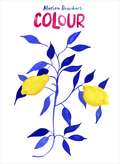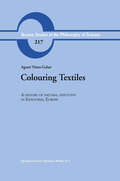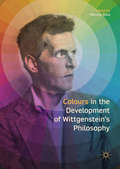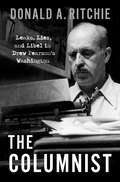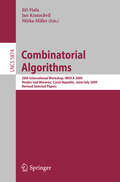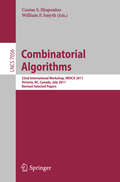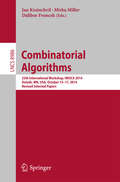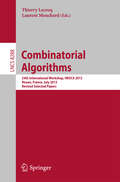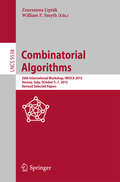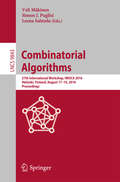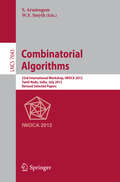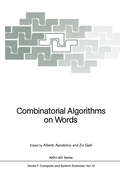- Table View
- List View
Color Theory: A Critical Introduction
by Aaron FineGiving an overview of the history of color theory from ancient and classical cultures to contemporary contexts, this book explores important critical principles and provides practical guidance on the use of color in art and design.Going beyond a simple recitation of what has historically been said about color, artist and educator Aaron Fine provides an intellectual history, critiquing prevailing Western ideas on the subject and challenging assumptions. He analyses colonialist and gendered attitudes, materialist and romanticist perspectives, spiritualist approaches to color, color in the age of reproduction, and modernist and post-modernist color strategies. Highlighted throughout are examples of the ways in which attitudes towards color have been impacted by the legacy of colonialism and are tied up with race, gender, and class. Topics covered include color models, wheels and charts, color interaction and theories of perception, with over 150 images throughout. By placing under-examined tenets of color theory such as the color wheel and color primaries within the Western industrial context that generated them, Fine helps you to connect color choices to color meanings and apply theory to practice.
Color Theory: A Critical Introduction
by Aaron FineGiving an overview of the history of color theory from ancient and classical cultures to contemporary contexts, this book explores important critical principles and provides practical guidance on the use of color in art and design.Going beyond a simple recitation of what has historically been said about color, artist and educator Aaron Fine provides an intellectual history, critiquing prevailing Western ideas on the subject and challenging assumptions. He analyses colonialist and gendered attitudes, materialist and romanticist perspectives, spiritualist approaches to color, color in the age of reproduction, and modernist and post-modernist color strategies. Highlighted throughout are examples of the ways in which attitudes towards color have been impacted by the legacy of colonialism and are tied up with race, gender, and class. Topics covered include color models, wheels and charts, color interaction and theories of perception, with over 150 images throughout. By placing under-examined tenets of color theory such as the color wheel and color primaries within the Western industrial context that generated them, Fine helps you to connect color choices to color meanings and apply theory to practice.
The Colorado Mathematical Olympiad: From the Mountains of Colorado to the Peaks of Mathematics
by Alexander SoiferNow in its third decade, the Colorado Mathematical Olympiad (CMO), founded by the author, has become an annual state-wide competition, hosting many hundreds of middle and high school contestants each year. This book presents a year-by-year history of the CMO from 2004–2013 with all the problems from the competitions and their solutions. Additionally, the book includes 10 further explorations, bridges from solved Olympiad problems to ‘real’ mathematics, bringing young readers to the forefront of various fields of mathematics. This book contains more than just problems, solutions, and event statistics — it tells a compelling story involving the lives of those who have been part of the Olympiad, their reminiscences of the past and successes of the present.I am almost speechless facing the ingenuity and inventiveness demonstrated in the problems proposed in the third decade of these Olympics. However, equally impressive is the drive and persistence of the originator and living soul of them. It is hard for me to imagine the enthusiasm and commitment needed to work singlehandedly on such an endeavor over several decades.After decades of hunting for Olympiad problems, and struggling to create Olympiad problems, he has become an extraordinary connoisseur and creator of Olympiad problems. The Olympiad problems were very good, from the beginning, but in the third decade the problems have become extraordinarily good. Every brace of 5 problems is a work of art. The harder individual problems range in quality from brilliant to work-of-genius… The same goes for the “Further Explorations” part of the book. Great mathematics and mathematical questions are immersed in a sauce of fascinating anecdote and reminiscence. If you could have only one book to enjoy while stranded on a desert island, this would be a good choice. Like Gauss, Alexander Soifer would not hesitate to inject Eureka! at the right moment. Like van der Waerden, he can transform a dispassionate exercise in logic into a compelling account of sudden insights and ultimate triumph.— Cecil Rousseau Chair, USA Mathematical Olympiad CommitteeA delightful feature of the book is that in the second part more related problems are discussed. Some of them are still unsolved.—Paul ErdősThe book is a gold mine of brilliant reasoning with special emphasis on the power and beauty of coloring proofs. Strongly recommended to both serious and recreational mathematicians on all levels of expertise. —Martin Gardner
The Colorado Mathematical Olympiad and Further Explorations: From the Mountains of Colorado to the Peaks of Mathematics
by Alexander SoiferThis updated printing of the first edition of Colorado Mathematical Olympiad: the First Twenty Years and Further Explorations gives the interesting history of the competition as well as an outline of all the problems and solutions that have been created for the contest over the years. Many of the essay problems were inspired by Russian mathematical folklore and written to suit the young audience; for example, the 1989 Sugar problem was written in a pleasant Lewis Carroll-like story. Some other entertaining problems involve olde Victorian map colourings, King Authur and the knights of the round table, rooks in space, Santa Claus and his elves painting planes, football for 23, and even the Colorado Springs subway system.
Colorblindness, Post-raciality, and Whiteness in the United States
by Sherrow O. PinderThis book problematizes the ways in which the discourses of colorblindness and post-raciality are articulated in the age of Obama. Pinder debunks the myth that race does not matter and reconsiders the presumptive hegemony of whiteness through the dialectics of visibility and invisibility of race.
Colour (Documents Of Contemporary Art Ser.)
by David BatchelorThis chronological anthology reflects on the aesthetic, cultural and philosophical meaning of colour to artists within the broader context of anthropology, film, philosophy and science. Those who loathe colour have had as much to say as those who love it. Establishing colour as a central theme in the story of modern art, this is an indispensable handbook to the definitions and debates around its history, meaning and use.
Colour: Colouring-in Notebook For Writing, Musing, Drawing And Doodling (The\original Pattern Journal Ser.)
by Marion DeucharsWhat makes a colour work? What do colours mean to artists or cultures? Why does grey make a colour stand out? What colour are the oceans? Why is the yellow of lemons something to treasure? Award-winning illustrator Marion Deuchars takes us on a journey through colour, showing how its language is at the centre of how we think and feel about the world. Colour is everywhere. Through this book, we can see it afresh.
The Colour Revolutions In The Former Soviet Republics: Successes And Failures (PDF)
by Donnacha Ó Beacháin Abel PoleseDuring the first decade of the 21stcentury, a remarkable phenomenon swept through the former Soviet Union changing the political, social and cultural landscape. Popularly known as the 'Colour Revolutions', these non-violent protests overthrew autocratic regimes in three post-soviet republics: the Georgian Rose Revolution (2003), the Ukrainian Orange Revolution (2004) and the Kyrgyzstani Tulip Revolution (2005). This book examines the significance of these regime-change processes for the post-soviet world in particular and for global politics in the 21stcentury. Engaging comprehensively with the former Soviet republics, the contributors to this book ask why there wasn't a revolution in a post-Soviet republic such as Russia, despite apparently favourable conditions. They also explore the circumstances that ensured some post-soviet countries underwent a successful colour revolution whilst others did not. Identifying the conditions for successful colour revolutions, this book asks whether there is a revolutionary blueprint that may be exported to other areas around the world that are under autocratic rule. Carefully considering the ideologies of the post-Soviet ruling regimes, this book demonstrates the manner by which political elites integrated nationalism, authoritarianism and populism into public debates. It analyzes the diverse anti-regime movements, discussing the factors that led to the rise of such factions and outlining how these opposition groups were constituted and operated. In addition, it assesses the impact of external forces including the influence of the USA, the EU and Russia. By examining the colour revolution phenomenon in its entirety, this book marks a significant contribution to both our micro and macro understanding of this tide of transformation.
Colour Vision: A Study in Cognitive Science and Philosophy of Science (Philosophical Issues in Science)
by Evan ThompsonColour fascinates all of us, and scientists and philosophers have sought to understand the true nature of colour vision for many years. In recent times, investigations into colour vision have been one of the main success stories of cognitive science, for each discipline within the field - neuroscience, psychology, linguistics, computer science and artificial intelligence, and philosophy - has contributed significantly to our understanding of colour. Evan Thompson's book is a major contribution to this interdisciplinary project. Colour Vision provides an accessible review of the current scientific and philosophical discussions of colour vision. Thompson steers a course between the subjective and objective positions on colour, arguing for a relational account. This account develops a novel `ecological' approach to colour vision in cognitive science and the philosophy of perception. It is vital reading for all cognitive scientists and philosophers whose interests touch upon this central area.
Colour Vision: A Study in Cognitive Science and Philosophy of Science (Philosophical Issues in Science)
by Evan ThompsonColour fascinates all of us, and scientists and philosophers have sought to understand the true nature of colour vision for many years. In recent times, investigations into colour vision have been one of the main success stories of cognitive science, for each discipline within the field - neuroscience, psychology, linguistics, computer science and artificial intelligence, and philosophy - has contributed significantly to our understanding of colour. Evan Thompson's book is a major contribution to this interdisciplinary project. Colour Vision provides an accessible review of the current scientific and philosophical discussions of colour vision. Thompson steers a course between the subjective and objective positions on colour, arguing for a relational account. This account develops a novel `ecological' approach to colour vision in cognitive science and the philosophy of perception. It is vital reading for all cognitive scientists and philosophers whose interests touch upon this central area.
Colouring Textiles: A History of Natural Dyestuffs in Industrial Europe (Boston Studies in the Philosophy and History of Science #217)
by A. Nieto-GalanColouring Textiles is an attempt to provide a new cross-cultural comparative approach to the art of dyeing and printing with natural dyestuffs in the eighteenth and nineteenth centuries. Divided into thematic chapters, it uncovers new data from the vast historical heritage of natural dyestuffs from a range of European cities, to present new historiographic insights for the understanding of this technology. Through a sort of anatomic dissection, the book explores the study and cultivation of dye-plants in botanical gardens and plantations, and the tacit values hidden in dyeing workshops, factories, laboratories, or national and international exhibitions. It metaphorically submits the natural dyestuffs of the eighteenth and nineteenth centuries to a series of systematic historical tests, and traces back the circulation of those sources of colours through colonial spaces, dye works, cross-cultural networks, schools of artistic design, and science-based industries for the making of synthetic colorants. Colouring Textiles contributes to a better understanding of the role of natural dyestuffs in the processes of industrialization in Western Europe. Audience: Historians of science and technology, historians of chemistry, philosophers, economic historians, professional chemists, arts and crafts historians, and cultural anthropologists.
Colours in the development of Wittgenstein’s Philosophy
by Marcos SilvaThis book presents and discusses the varying and seminal role which colour plays in the development of Wittgenstein’s philosophy. Having once said that “Colours spur us to philosophize”, the theme of colour was one to which Wittgenstein returned constantly throughout his career. Ranging from his Notebooks, 1914-1916 and the Tractatus Logico-Philosophicus to the posthumously published Remarks on Colours and On Certainty, this book explores how both his view of philosophical problems generally and his view on colours specifically changed considerably over time. Paying particular attention to his so-called intermediary period, it takes a case-based approach to the presentation of colour in texts from this period, from Some Remarks on Logical Form and Philosophical Remarks to his Big Typescript.
Colours in the development of Wittgenstein’s Philosophy
by Marcos SilvaThis book presents and discusses the varying and seminal role which colour plays in the development of Wittgenstein’s philosophy. Having once said that “Colours spur us to philosophize”, the theme of colour was one to which Wittgenstein returned constantly throughout his career. Ranging from his Notebooks, 1914-1916 and the Tractatus Logico-Philosophicus to the posthumously published Remarks on Colours and On Certainty, this book explores how both his view of philosophical problems generally and his view on colours specifically changed considerably over time. Paying particular attention to his so-called intermediary period, it takes a case-based approach to the presentation of colour in texts from this period, from Some Remarks on Logical Form and Philosophical Remarks to his Big Typescript.
The Columnist: Leaks, Lies, and Libel in Drew Pearson's Washington
by Donald A. RitchieLong before Wikileaks and social media, the journalist Drew Pearson exposed to public view information that public officials tried to keep hidden. A self-professed "keyhole peeper", Pearson devoted himself to revealing what politicians were doing behind closed doors. From 1932 to 1969, his daily "Washington Merry-Go-Round" column and weekly radio and TV commentary broke secrets, revealed classified information, and passed along rumors based on sources high and low in the federal government, while intelligence agents searched fruitlessly for his sources. For forty years, this syndicated columnist and radio and television commentator called public officials to account and forced them to confront the facts. Pearson's daily column, published in more than 600 newspapers, and his weekly radio and television commentaries led to the censure of two US senators, sent four members of the House to prison, and undermined numerous political careers. Every president from Franklin Roosevelt to Richard Nixon--and a quorum of Congress--called him a liar. Pearson was sued for libel more than any other journalist, in the end winning all but one of the cases. Breaking secrets was the heartbeat of Pearson's column. His ability to reveal classified information, even during wartime, motivated foreign and domestic intelligence agents to pursue him. He played cat and mouse with the investigators who shadowed him, tapped his phone, read his mail, and planted agents among his friends. Yet they rarely learned his sources. The FBI found it so fruitless to track down leaks to the columnist that it advised agencies to simply do a better job of keeping their files secret. Drawing on Pearson's extensive correspondence, diaries, and oral histories, The Columnist reveals the mystery behind Pearson's leaks and the accuracy of his most controversial revelations.
The Columnist: Leaks, Lies, and Libel in Drew Pearson's Washington
by Donald A. RitchieLong before Wikileaks and social media, the journalist Drew Pearson exposed to public view information that public officials tried to keep hidden. A self-professed "keyhole peeper", Pearson devoted himself to revealing what politicians were doing behind closed doors. From 1932 to 1969, his daily "Washington Merry-Go-Round" column and weekly radio and TV commentary broke secrets, revealed classified information, and passed along rumors based on sources high and low in the federal government, while intelligence agents searched fruitlessly for his sources. For forty years, this syndicated columnist and radio and television commentator called public officials to account and forced them to confront the facts. Pearson's daily column, published in more than 600 newspapers, and his weekly radio and television commentaries led to the censure of two US senators, sent four members of the House to prison, and undermined numerous political careers. Every president from Franklin Roosevelt to Richard Nixon--and a quorum of Congress--called him a liar. Pearson was sued for libel more than any other journalist, in the end winning all but one of the cases. Breaking secrets was the heartbeat of Pearson's column. His ability to reveal classified information, even during wartime, motivated foreign and domestic intelligence agents to pursue him. He played cat and mouse with the investigators who shadowed him, tapped his phone, read his mail, and planted agents among his friends. Yet they rarely learned his sources. The FBI found it so fruitless to track down leaks to the columnist that it advised agencies to simply do a better job of keeping their files secret. Drawing on Pearson's extensive correspondence, diaries, and oral histories, The Columnist reveals the mystery behind Pearson's leaks and the accuracy of his most controversial revelations.
Combinatorial Algebra: Syntax And Semantics (Springer Monographs in Mathematics)
by Mark V. SapirCombinatorial Algebra: Syntax and Semantics provides comprehensive account of many areas of combinatorial algebra. It contains self-contained proofs of more than 20 fundamental results, both classical and modern. This includes Golod–Shafarevich and Olshanskii's solutions of Burnside problems, Shirshov's solution of Kurosh's problem for PI rings, Belov's solution of Specht's problem for varieties of rings, Grigorchuk's solution of Milnor's problem, Bass–Guivarc'h theorem about growth of nilpotent groups, Kleiman's solution of Hanna Neumann's problem for varieties of groups, Adian's solution of von Neumann-Day's problem, Trahtman's solution of the road coloring problem of Adler, Goodwyn and Weiss. The book emphasize several ``universal" tools, such as trees, subshifts, uniformly recurrent words, diagrams and automata. With over 350 exercises at various levels of difficulty and with hints for the more difficult problems, this book can be used as a textbook, and aims to reach a wide and diversified audience. No prerequisites beyond standard courses in linear and abstract algebra are required. The broad appeal of this textbook extends to a variety of student levels: from advanced high-schoolers to undergraduates and graduate students, including those in search of a Ph.D. thesis who will benefit from the “Further reading and open problems” sections at the end of Chapters 2 –5. The book can also be used for self-study, engaging those beyond the classroom setting: researchers, instructors, students, virtually anyone who wishes to learn and better understand this important area of mathematics.
Combinatorial Algorithms: 20th International Workshop, IWOCA 2009, Hradec nad Moravicí, Czech Republic, June 28--July 2, 2009, Revised Selected Papers (Lecture Notes in Computer Science #5874)
by Jiri Fiala Jan Kratochvil Mirka MillerThis book constitutes the revised selected papers of the 20th International Workshop on Combinatorial Algorithms, held in June/July 2009 in the castle of Hradec nad Moravicí, Czech Republic. The 41 papers included in this volume together with 5 invited papers were carefully reviewed and selected from over 100 submissions. The topics dealt with are algorithms and data structures, applications, combinatorial enumeration, combinatorial optimization, complexity theory, computational biology, databases, decompositions and combinatorial designs, discrete and computational geometry, including graph drawing, and graph theory and combinatorics.
Combinatorial Algorithms: 22th International Workshop, IWOCA 2011, Victoria, Canada, July 20-22, 2011, Revised Selected Papers (Lecture Notes in Computer Science #7056)
by Costas S. Iliopoulos William F. SmythThis book constitutes the thoroughly referred post-workshop proceedings of the 22nd International Workshop on Combinatorial Algorithms, IWOCA 2011, held in Victoria, BC, Canada, in July 2011. The 30 revised full papers presented were carefully reviewed and selected from a total of 71 submissions. A broad variety of topics in combinatorics and graph theory are addressed, such as combinatorics on words, string algorithms, codes, Venn diagrams, set partitions; Hamiltonian & Eulerian properties, graph drawing, colouring, dominating sets, spanning trees, and others.
Combinatorial Algorithms: 25th International Workshop, IWOCA 2014, Duluth, MN, USA, October 15-17, 2014, Revised Selected Papers (Lecture Notes in Computer Science #8986)
by Jan Kratochvíl Mirka Miller Dalibor FroncekThis book constitutes the thoroughly refereed post-workshop proceedings of the 25th International Workshop on Combinatorial Algorithms, IWOCA 2014, held in Duluth, MN, USA, in October 2014. The 32 revised full papers presented were carefully reviewed and selected from a total of 69 submissions. The papers focus on topics such as Algorithms and Data Structures, Combinatorial Enumeration, Combinatorial Optimization, Complexity Theory (Structural and Computational), Computational Biology, Databases (Security, Compression and Information Retrieval), Decompositions and Combinatorial Designs, Discrete and Computational Geometry, as well as Graph Drawing and Graph Theory. IWOCA is a yearly forum for researchers in designing algorithms field to advance creativeness of intersection between mathematics and computer science. This is the first time this conference is being held in U.S.
Combinatorial Algorithms: 24th International Workshop, IWOCA 2013, Rouen, France, July 10-12, 2013. Revised Selected Papers (Lecture Notes in Computer Science #8288)
by Thierry Lecroq Laurent MouchardThis book constitutes the thoroughly refereed post-workshop proceedings of the 24th International Workshop on Combinatorial Algorithms, IWOCA 2013, held in Rouen, France, in July 2013. The 33 revised full papers presented together with 10 short papers and 5 invited talks were carefully reviewed and selected from a total of 91 submissions. The papers are organized in topical sections on algorithms on graphs; algorithms on strings; discrete geometry and satisfiability.
Combinatorial Algorithms: 26th International Workshop, IWOCA 2015, Verona, Italy, October 5-7, 2015, Revised Selected Papers (Lecture Notes in Computer Science #9538)
by Zsuzsanna Lipták William F. SmythThis book constitutes the thoroughly refereed post-workshop proceedings for the 26 International Workshop on combinatorial Algorithms, IWOCA 2015, held in Verona, Italy, in October 2015.The 29 revised full papers presented were carefully reviewed and selected from a total of 90 submissions. The topics of the papers include algorithms and data structures (including sequential, parallel, distributed, approximation, probabilistic, randomised, and on-line algorithms), algorithms on strings and graphs; applications (bioinformatics, music analysis, networking, and others); combinatorics on words; combinatorial enumeration; combinatorial optimization; complexity theory; computational biology; compression and information retrieval; cryptography and information security; decompositions and combinatorial designs; discrete and computational geometry; graph drawing and labeling; graph theory.
Combinatorial Algorithms: 27th International Workshop, IWOCA 2016, Helsinki, Finland, August 17-19, 2016, Proceedings (Lecture Notes in Computer Science #9843)
by Veli Mäkinen Simon J. Puglisi Leena SalmelaThis book constitutes the proceedings of the 27th International Workshop on Combinatorial Algorithms, IWOCA 2016, held in Helsinki, Finland, in August 2016. The 35 papers presented in this volume were carefully reviewed and selected from 87 submissions. They were organized in topical sessions named: computational complexity; computational geometry; networks; enumeration; online algorithms; algorithmic graph theory; dynamic programming; combinatorial algorithms; graph algorithms; combinatorics; and probabilistics.
Combinatorial Algorithms: 23rd International Workshop, IWOCA 2012, Krishnankoil, India, July 19-21, 2012, Revised Selected Papers (Lecture Notes in Computer Science #7643)
by W. F. Symth Subramanian ArumugamThis book constitutes the thoroughly referred post-workshop proceedings of the 23rd International Workshop on Combinatorial Algorithms, IWOCA 2012, held in Krishnankoil, Tamil Nadu, India, in July 2012. The 32 revised full papers presented were carefully reviewed and selected from a total of 88 submissions. The papers are organized in topical sections in algorithms and data Structures, applications (including Bioinformatics, Networking, etc.), combinatorics of words and strings, combinatorial optimization, combinatorial enumeration, decompositions and combinatorial designs, complexity theory (structural and computational), computational biology and graph theory and combinatorics submissions.
Combinatorial Algorithms on Words (NATO ASI Subseries F: #12)
by Alberto Apostolico Zvi GalilCombinatorial Algorithms on Words refers to the collection of manipulations of strings of symbols (words) - not necessarily from a finite alphabet - that exploit the combinatorial properties of the logical/physical input arrangement to achieve efficient computational performances. The model of computation may be any of the established serial paradigms (e.g. RAM's, Turing Machines), or one of the emerging parallel models (e.g. PRAM ,WRAM, Systolic Arrays, CCC). This book focuses on some of the accomplishments of recent years in such disparate areas as pattern matching, data compression, free groups, coding theory, parallel and VLSI computation, and symbolic dynamics; these share a common flavor, yet ltave not been examined together in the past. In addition to being theoretically interest ing, these studies have had significant applications. It happens that these works have all too frequently been carried out in isolation, with contributions addressing similar issues scattered throughout a rather diverse body of literature. We felt that it would be advantageous to both current and future researchers to collect this work in a sin gle reference. It should be clear that the book's emphasis is on aspects of combinatorics and com plexity rather than logic, foundations, and decidability. In view of the large body of research and the degree of unity already achieved by studies in the theory of auto mata and formal languages, we have allocated very little space to them.
Combinatorial Set Theory: With a Gentle Introduction to Forcing (Springer Monographs in Mathematics)
by Lorenz J. HalbeisenThis book, now in a thoroughly revised second edition, provides a comprehensive and accessible introduction to modern set theory.Following an overview of basic notions in combinatorics and first-order logic, the author outlines the main topics of classical set theory in the second part, including Ramsey theory and the axiom of choice. The revised edition contains new permutation models and recent results in set theory without the axiom of choice. The third part explains the sophisticated technique of forcing in great detail, now including a separate chapter on Suslin’s problem. The technique is used to show that certain statements are neither provable nor disprovable from the axioms of set theory. In the final part, some topics of classical set theory are revisited and further developed in light of forcing, with new chapters on Sacks Forcing and Shelah’s astonishing construction of a model with finitely many Ramsey ultrafilters.Written for graduate students in axiomatic set theory, Combinatorial Set Theory will appeal to all researchers interested in the foundations of mathematics. With extensive reference lists and historical remarks at the end of each chapter, this book is suitable for self-study.






